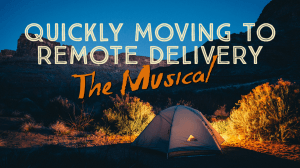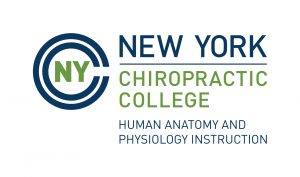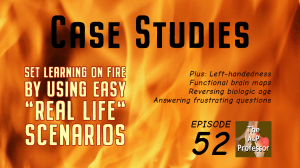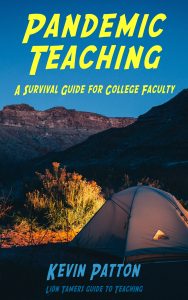Quickly Moving to Remote Delivery—The Musical
Special Bonus Episode 64b
Bonus Episode
Episode | Quick Take
In this “emergency” bonus episode, host Kevin Patton outlines ways to quickly move our courses from on-campus venues to remote delivery during a public health event. And sing along with Greg Crowther to keep our spirits up!
00:42 | Let’s Move!
01:50 | Support Our Sponsors
02:36 | Sing a Song. Sing It Loud.
11:54 | Sights and Sounds
18:18 | Sing It Strong
20:41 | Keeping It Real
26:11 | Stay Connected
Episode | Listen Now
Episode | Show Notes
All adventures, especially into new territory, are scary. (Sally Ride)
Let’s Move!
1 minute
We’ve been told to pack up and move our course home from campus to the nebulous and scary “remote.” What to do?!
- Mid-Winter Winterizing of Our Courses | Bonus Episode 63 (the prep work we should have done—but it’s not too late!)
- Previews (yep, there are two) to the next “regular” episode. Get ready now (remember that prepping you forgot to do?)
Support Our Sponsors
1 minute
Want to continue free access to this podcast. Well, then maybe clicking a few links may be worth your while…
Human Anatomy & Physiology Instruction (HAPI)Online graduate program for holders of advanced degrees who want a comprehensive review of core principles of both anatomy and physiology, introduction to contemporary teaching practice, hands-on practice in course design and implementation, navigating the roles of college faculty, and collaboration with peers in building a solid portfolio in teaching human anatomy and physiology.
American Association for Anatomy (AAA)
- A searchable transcript for this episode, as well as the captioned audiogram of this episode, are sponsored by the American Association for Anatomy (AAA) at anatomy.org.
- Don’t forget—HAPS members get a deep discount on AAA membership!
The Human Anatomy & Physiology Society (HAPS)
You can help appreciate their support by clicking the link below and checking out the many resources and benefits found there.
Sing a Song. Sing It Loud.
9 minutes
The first 6 tips—out of one million, er… 19, total in this episode. Plus a sing-along. Really.
- Tips
- 1. Don’t forget to breathe.
- 2. Pretend you’re going to that cancelled conference.
- 3. Less is more.
- 4. Ask for help.
- 5. Involve the world.
- 6. Involve students.
- Don’t forget to breathe! (blog post for students) my-ap.us/39TyfBZ
- Making Mistakes Teaching Anatomy & Physiology | Episode 63 (it’s okay—really!)
- The Sodium Jeer about cells keeping sodium (Na+) out. Na, Na, Na… This can help students remember where sodium is and how it behaves in a variety of physiological processes. (Warning: ear bug)
- faculty.washington.edu/crowther/Misc/Songs/jeer.shtml
- Includes guidance, study questions, lyrics, sound file, sheet music (with melody play-back)
- Lyrics (let’s all sing along, okay?):
Na Na Na Na Na Na!
Sodium can’t get in! - Additional lyrics (when sodium channel open, produding a “funny” current)
Ha Ha Ha Ha Ha Ha!
Sodium CAN get in!
- faculty.washington.edu/crowther/Misc/Songs/jeer.shtml
- Fick’s Law of Diffusion about the equation for calculating diffusion rates.
- faculty.washington.edu/crowther/Misc/Songs/fick.shtml
- Includes guidance, lesson plan, study questions, lyrics, sound file, music video, sheet music (with melody play-back)
- Lyrics (are you singing along?):
Fick says how quick, A molecule will diffuse.
Delta P times A times k, Over D is the law to use.Fick says how quick, A molecule will diffuse.
Delta P times A times k, Over D is the law to use.(Fick) Pressure difference,
(Fick) Surface area,
(Fick) And the constant k
Are multiplied together.
(Fick) They’re divided by
(Fick) Diffusion barrier
(Fick) To determine the exact rate of diffusion.
- faculty.washington.edu/crowther/Misc/Songs/fick.shtml
- Used by permission. But these are meant to be shared. Thanks Greg Crowther!
Sights and Sounds
6.5 minute
The next seven tips…
- Tips
- 7. Remote is not always online.
- 8. Do some video.
- 9. Do some audio.
- 10. Keep things brief.
- 11. Be nimble.
- 12. Teach by testing.
- 13. Testing is not always teaching.
- TechSmith is helping organizations and academic institutions who are preparing for prolonged absences and/or campus closures due to COVID-19. They are offering free access and expanded usage of tools that help enable educational continuity. my-ap.us/3aNBB9M
- Online Lecture Previews (my online seminar about my approach to online videos; can be adapted a number of ways)
- Kevin Flaherty’s amazing, stupendous collection of resources: my-ap.us/FlahertyResources
- Powerful Teaching: Unleash the Science of Learning (book on retrieval practice and other ideas by Pooja K. Agarwal & Patrice M. Bain) amzn.to/2O4ZPUe
- Testing As a Teaching Strategy | Episode 2
- Spaced Retrieval Practice | Episode 1
- Testing as Teaching (my seminar on using formative testing as a learning process; can be adapted for emergency remote learning)
Sing it Strong
2.5 minutes
Another musical interlude. Yep, for singing along. And learning. After all, isn’t that what musicals are for?
- Greg Crowther’s STEM songs website (you gotta see this) faculty.washington.edu/crowther/Misc/Songs/
- The Place Principle about how pitches are transduced at different places along the cochlea.
- faculty.washington.edu/crowther/Misc/Songs/place.shtml
- Includes context, lesson plan, study questions, karaoke, sound file, sheet music, more!
- Lyrics:
Which pitch will make your hair cells twitch?
(Doo, doot, doo, doot.)
Which pitch will make your hair cells twitch?
(Doo, doot, doo, doot.)
When I talk to ya through your cochlea?
(Doo, doot, doo, doot.)
When I talk to ya through your cochlea?
(Doo, doot, doo, doot.)
From apex to base, each pitch has a place!
(Doo, doot, doo, doot.)
From apex to base, each pitch has a place!
(Doo, doot, doo, doot.)
When I talk to ya through your cochlea,
You’ll hear; you’ll hear!
When I talk to ya through your cochlea,
You’ll hear; you’ll hear! - Used by permission, thanks to Greg Crowther.
- Spinal Nerve Plexuses about which nerves contribute to which plexuses.
- faculty.washington.edu/crowther/Misc/Songs/plexuses.shtml
- Lyrics, context, karaoke, sheet music
Keeping it Real
5.5 minutes
The next six tips. Real ones. About reality. Or not.
- Tips
- 14. Read the book.
- 15. Just in case.
- 16. Learning is art and art is learning.
- 17. Simulate reality.
- 18. Embrace reality.
- 19. No side trips.
- READ and RAID your textbook! (blog post for students about how to effectively use their textbook) my-ap.us/ReadRaid
- The Case for Case Studies | Episode 52
Survey Says…
- Please take about 5 minutes to answer some questions—it will really help improve this podcast!
- Yes; I’ll give you extra credit if you fill out a survey!
- theAPprofessor.org/survey
Need help accessing resources locked behind a paywall?
Check out this advice from Episode 32 to get what you need!
Episode | Captioned Audiogram
Episode | Transcript
The A&P Professor podcast (TAPP radio) episodes are made for listening, not reading. This transcript is provided for your convenience, but hey, it’s just not possible to capture the emphasis and dramatic delivery of the audio version. Or the cool theme music. Or laughs and snorts. And because it’s generated by a combo of machine and human transcription, it may not be exactly right. So I strongly recommend listening by clicking the audio player provided.
 This searchable transcript is supported by the
This searchable transcript is supported by the
American Association for Anatomy.
I'm a member—maybe you should be one, too!
Kevin Patton:
The astronaut, Sally Ride, said that all adventures, especially into new territory, are scary.
Aileen:
Welcome to The A&P Professor. A few minutes to focus on teaching human anatomy and physiology with a veteran educator and teaching mentor, your host, Kevin Patton.
Kevin Patton:
In this episode, I talk about moving an A&P course from an on-campus venue to remote delivery. Well, it had to come sooner or later, a pandemic. A pandemic forcing social distancing measures that include moving face-to-face courses to a remote format with little or no lead time. And now it’s time. Yikes.
Kevin Patton:
Hopefully, you started getting prepared for that a few weeks ago when I released a previous bonus episode, episode 63b, which was all about how to get ready for possible disruptions. And well, they’re here.
Kevin Patton:
So, I’m following up with this special emergency bonus episode to give a bunch of practical tips and general advice on actually doing it, now that the time has come. And don’t worry. That regular episode featuring my conversation with memory expert, Chase DiMarco, from FreeMedEd is still coming out on Monday as scheduled. But I thought that you could use the advice I’ll be giving you sooner rather than later.
Kevin Patton:
Rather than have separate sponsor breaks like I usually do, I’m going to mention them all right now and only very briefly, because this is an emergency and we have to get to the work at hand. We’re all grateful for the support for this episode that comes from the American Association for Anatomy, AAA, the Human Anatomy and Physiology Society, HAPS, and the Master of Science in Human Anatomy and Physiology Instruction, the HAPI degree. Links to all these sponsors are found in the show notes and at the episode page at theAPprofessor.org/64b.
Kevin Patton:
Here we go. 1 million tips to consider when you face the situation of quickly converting all or part of your course to an online only format. Well, maybe not quite a million, but at least 19. Before I jump right into them, I want to mention that I have lengths for related resources in the show notes in the episode page as I’ve mentioned already. Once again, it’s theAPprofessor.org/64b.
Kevin Patton:
So, tip number one, don’t forget to breathe. It’s going to be okay. Folks will expect our best effort and trying but not perfect results. How could they? We all understand that it’s not even plan B. It’s an unplanned emergency fallback. So, stay calm and don’t forget to breathe.
Kevin Patton:
If you can’t calm down, at least act calm when dealing with students. They’ll need reassurance and it’s up to us to put our calm faces on. Not only will your students need reassurance, reminders to keep breathing, but they’ll be disoriented, probably more disoriented than you are right now. Yes, it is possible to be more disoriented than you and I are right now. So, we need to keep things organized in as clear and simple a manner as possible.
Kevin Patton:
And we have to likewise be very clear about our expectations of our students, which honestly, should be in some ways lower expectations than usual during this emergency situation. Now, you’ve heard me preach about this a lot, so I’ll just mention it briefly now, and that is, be extra empathetic and extra compassionate. Not everyone deals with emergencies and sudden changes with the cool resolve that you and I do. So why not cut them some slack?
Kevin Patton:
Tip number two, pretend you’re going to that canceled conference. So, let’s say that the conference you planned to go to was really going to go on as scheduled anyway. What were you going to do about your courses while you were gone? Yeah, do that. Possibly you made arrangements for students self-study or remote activities or video lectures or something along those lines. So, like I said, do that.
Kevin Patton:
However, if your plan was to have your friend sub for you in your course, that’s not going to work. But what if you were going out of town for a while and getting a sub was not an option. Do that.
Kevin Patton:
Tip number three, less is more. You’ve heard this teaching advice a bazillion times, right? Maybe more, and possibly winced every time you heard it, thinking, where can I cut my course? Every concept is important. Well, this is an emergency. You can’t take everything with you as you evacuate your comfortable course home. So, what will you take? You must decide quickly. Just do it. There isn’t time to hem and haw.
Kevin Patton:
And don’t try to build an entire online course now. Nobody is expecting that. That can take years. This is more like moving into an RV or a tent for a few weeks. You’re only temporarily abandoning your course’s home. Everyone realizes that, and you should too. Take with you just the concepts and just the activities and the assessments you absolutely need.
Kevin Patton:
And you know what? This lightweight new thing you’re throwing together, it’ll all work out, I promise. You know in your heart of hearts the core concepts that your students really must walk away from your course with. Leaner is meaner anyway. Trust me.
Kevin Patton:
Tip number four, ask for help. Stay in contact with your teaching peers within your department and beyond. You’ll all be struggling with this and each will have different ideas and methods and consoling words to share with each other. Your institution will likely have all kinds of help and advice for you. Your textbook publisher may have resources. Your professional organization will have resources. All kinds of resources are going to be out there on social media. So don’t hesitate to ask for help.
Kevin Patton:
Tip number five, involve the world. Many have gone before you and me on this journey. There are a lot of free images, videos, audio, and more available online. Ask your students to help find them. Ask colleagues to help and share your finds with them.
Kevin Patton:
Tip number six, involve students. There are several possible ways that we can involve students in this process and probably have a blast doing so. Invite students to provide suggestions on ways to reach your course objectives. This makes them part of the all hands on deck emergency nature of the situation, and provides that all important feeling of autonomy that helps motivate learning.
Kevin Patton:
Consider adding online discussions of concepts or topics, so that students can work out things among themselves maybe with your gentle guidance. This can be uncomfortable at first for those who’ve never done it, but I’ve been surprised at how well this can work. Students may also be able to help you with some of the technical challenges of producing media or other aspects of online instruction if you’re new to all this.
Kevin Patton:
A different aspect of this tip to involve students, and this hearkens back to some of the previous ideas I’ve mentioned about empathy and compassion, is to try to be extra available to students. Stay in touch. Let them know how they can stay in touch. Sometimes, just an open discussion forum where they can discuss anything at any time may do the trick.
Kevin Patton:
Or your learning management system, your LMS, or maybe some other institutional tools that you have available. It might include things like text or video chat or meeting capabilities, which could be used to have scheduled tutorials or town hall meetings or I don’t know, sing-alongs. Okay, I know. That sounds silly. Sing-alongs? And I guess it is silly, but I mean it. If you can do a group audio or video meeting, then why not get silly and have a sing-along? Can’t sing? That’s even better. It will be more fun.
Kevin Patton:
And also, being willing to be vulnerable during an emergency can really have powerful reassuring effects with our students. Hey, if you do sing-alongs, I want to hear about it. And if you need some A&P songs to sing, I got you covered. I have a link to my friend Greg Crowther’s huge library of A&P songs in the show notes in the episode page.
Kevin Patton:
Now, the title of this episode says, it’s a “Musical.” And I mean it. So, here with two of his simplest songs for use in a classroom sing-along, is Greg Crowther. This first one is a chant about sodium, the symbol Na, which cells want to keep out. Hey, let’s sing-along. The lyrics are in the show notes in the episode page. (singing)
Kevin Patton:
This next one is about fixed law of diffusion. Here we go. (singing)
Kevin Patton:
Now, either of these songs could be a brief, simple, fun sing-along activity, right? Stay tuned because I have another of Greg’s songs coming up later in this episode.
Kevin Patton:
Okay. Let’s move on with some more tips. Tip number seven, remote is not always online. These days, we often say online when what we really mean is remote. Most of us with face-to-face courses are being told to put everything online now, or maybe really what they’re saying to us is remote and what we’re hearing is online.
Kevin Patton:
But you know what? You or I may not have to move anything or much of anything online at all. There may be assignments and readings that students were already planning to work on, or at least we hope they were. We could just email them or post an announcement in the learning management system to, well, just carry on. Maybe have them submit their assignments and grade them and give them feedback back and a grade. And that’s all we need to do.
Kevin Patton:
Tip number eight, do some video. Even if you’ve never ever done a video clip, now is a good time to just jump in and do it. It’ll be fun. The water is fine, so jump. There are loads of YouTube videos and other tutorials online that can help you do this. Your institution probably has loads of resources on how to get started and links to institutional software and other tools to use.
Kevin Patton:
Your students don’t expect a Ron Howard film or a Morgan Freeman voiceover. They just expect you being you. In fact, the more like you you can be, the more comfortable you and your students will be during this weird adventure that we’re all on right now, or maybe slightly more laid back and casual you might be in order, to engender that all important, we’re all in this together vibe that we want to create right now.
Kevin Patton:
Tip number nine, do some audio. In visual courses such as anatomy and physiology, you probably need at least some images for some of your instructional media, but consider supplementing with audio. And remember, your textbook and our lab manual or lab atlas and so on probably has a lot of the images you need anyway.
Kevin Patton:
Now, audio is often even easier than video and students love it. They’re part of the podcast generation after all and they can stream it to their mobile device and listen while they’re doing other stuff like organizing their survival bunkers’ supply of toilet paper and bottled water. You’ll be right in their ears as if you’re sitting on their shoulder and sharing your insights.
Kevin Patton:
Tip number 10, keep things brief. The knee-jerk response to switching from live to video and audio is to simply do lectures that you’d give in a classroom into a camera and/or a mic. You do that if you want. If your anxiety level is climbing, that may be the best strategy for you, but remember an earlier point about less being more. Consider just doing really brief media clips.
Kevin Patton:
It’s easier to hold attention and to do effective instruction in short bursts when working remotely. Trust me on this one too. If you must spend a lot of time on a topic, then break it up into short clips, but consider taking those long-winded presentations and chop, chop, chop them into a simpler, easier-to-digest version.
Kevin Patton:
Tip number 11, be nimble. In the martial art called Tai Chi Chuan, one way that we practice being nimble is to always keep our knees flexed a bit, like cats do when they’re on their prowl. Doing that, one can quickly move with great power into any of several defensive positions. So, let’s do that. Let’s be nimble by being ready to shift positions quickly in response to what’s happening in our course. Ready to change directions if we have to. Expecting to have to shift some things around.
Kevin Patton:
If you’re a regular listener, you knew I was going to work in a Tai Chi analogy somewhere, right? You’re probably also waiting for me to somehow work in the term carbaminohemoglobin. But you know what? I just could not find an angle. So you won’t be hearing me say carbaminohemoglobin at all in this podcast because carbaminohemoglobin just doesn’t apply right now.
Kevin Patton:
Tip number 12, teach by testing. Give a lot of low stakes, open book, multiple attempt quizzes and tests. Retrieval practice, anyone? I’ve been preaching this message for decades, but even in face-to-face courses, this strategy is a game changer. Now is a good opportunity and try and prove me wrong.
Kevin Patton:
Tip number 13, testing is not always teaching. Okay, wait, really? I think that testing is always teaching something, but there’s the formative kind of testing I was just talking about, that is all about retrieval practice. And then, there’s the summative kind of evaluation after students have had a chance to do retrieval practice. And this summative testing tests the final outcome of learning.
Kevin Patton:
Maybe for this emergency, we could just combine them and call the formative testing summative. What I picture when I say this is that we could allow multiple attempts at an online test with only the best score counting toward the course grade. That would allow students to do retrieval practice until they gain more and more mastery. Now, I have some links in the show notes in the episode page at theAPprofessor.org/64b that explain more fully what I mean by this.
Kevin Patton:
Well, let’s pause for a moment for another brief musical interlude from Greg Crowther. This one’s a calling response song about the place principle in the process of hearing.(singing)
Kevin Patton:
Greg Crowther is a dedicated and creative A&P teacher, besides being a rock star, literally a rock star, in creating and using music in STEM education. If you haven’t explored his many, many songs that relate to A&P education, you really need to do that. When you go to that link in the show notes or episode page, you’ll also find a link to the page for another of Greg’s pieces that’s great for a sing-along. That one helps students learn some basic ideas about spinal nerve plexuses.
Kevin Patton:
When you go there, check out the fact that Greg provides many different ways to experience his songs. For this one about nerve plexuses, one of the options is a karaoke screen that you and your students can follow as you sing. Really, you need to check these out.
Kevin Patton:
Tip number 14, read the book. You know that unreasonably large and expensive textbook the students bought for your course, now is the perfect opportunity to get them to actually read it. They’ll be socially distance anyway, one hopes, and looking for something to read.
Kevin Patton:
Most students raid their textbook rather than actually reading it. Now’s a good time to turn the reading of the book into a bigger element of the course. If you keep your instructor-provided explanations at a minimum, as I advised in an earlier segment, then students have no choice but to get a lot of the needed information from their textbook.
Kevin Patton:
Tip number 15, just in case, consider substituting your planned lecture or class activity with a case study. There are plenty of these case studies available online, but I’ve found it to be fun making up my own. It’s much easier than you think if you’ve never done it. I often use medical images and make up a story around it, and then ask questions about the scenario that tease out important concepts of anatomy or physiology.
Kevin Patton:
One option would be to post that. Maybe divide the class up into groups in your learning management system and give each one a different case to work out. And then, post it in a discussion forum just for that group. And there are easy ways to do that. Your folks at your institution will help you figure out how to do that. And then, have them work out the case and then have each group present their case to the other groups and what their conclusion was and why.
Kevin Patton:
Tip number 16, learning is art and art is learning. Drawing. Drawing is a powerful learning strategy. Nearly everyone can draw. Sure, some folks are regular DaVincis when they draw, but many of us, maybe most of us are not. And that’s okay. Making stick and ball figures can work just as well as the more realistic kind of art.
Kevin Patton:
This can really help with lab activities when the lab’s not available. Consider drawing and labeling exercises, drawing out concept maps, making organs from household items like paper or dough or scraps of fabric. Bake a cake in the shape of an organ and have them share a picture of it online. Things like that.
Kevin Patton:
Tip number 17, simulate reality. Even if we’ve never used computer simulations of anatomical structures or physiological functions, we know they’ve been around for a while. Your institution may already provide access to some of these, and there are some available online at no cost. I provided links to a few of them, but go out searching. Send your students out searching and play around with them, and see how that might fit into your remote-learning scenario.
Kevin Patton:
Tip number 18, embrace reality. If things go well, any temporary move of your face-to-face class to the online environment is, well, temporary, probably a few weeks. Then the emergency will have passed and we’re back to our usual mode. So, it may be nerve wracking, but normalcy will return soon, right?
Kevin Patton:
Tip number 19, no side trips. Somebody in your course, maybe you, might suggest that you’re suspended on-campus class should meet somewhere off campus, maybe a cafe or a restaurant. After all, these venues are likely to be virtually deserted and would welcome even a little bit of business. Do not do it. Do not. That would defeat the whole purpose of suspending face-to-face class meetings, which is to slow or even break the cycle of the viral outbreak. We’re not doing this just for us. We’re doing it as part of our social obligation to support and protect each other. So, let’s keep that our priority.
Kevin Patton:
There are a lot of other things that we can do quickly and easily once we put our minds to it, and hopefully, this short list has already stimulated some ideas. One final thought. Let’s look at this, at the adventure it is. The universe has thrown an unexpected challenge at us. Let’s rise to the occasion and tap our creativity and our experience to make some awesome lemonade out of those lemons. Our positive can-do attitude can go a long way to reassure our students and to motivate them to do some strong self-powered learning.
Kevin Patton:
As I mentioned several times earlier, I put links in the show notes and at the episode page at theAPprofessor.org/64b. In case you want to further explore any ideas mentioned in this podcast, or if you want to visit our sponsors, tell us what’s going on with you, your tips and suggestions, and your questions at the podcast’s hotline. That’s 1-833-LION-DEN or 1-833-546-6336. Or send a recording or a written message to podcast@theAPprofessor.org. I’ll see you down the road.
Aileen:
The A&P Professor is hosted by Dr. Kevin Patton, an award-wining professor and textbook author in human anatomy and physiology.
Kevin Patton:
Please wash your hands thoroughly before and after listening to this episode. As a member of the barely over 60 crowd, I’m grateful for your enthusiastic support of public health measures that reduce health risks to me and mine. Cheers. (singing)
This podcast is sponsored by the
Human Anatomy & Physiology Society 
This podcast is sponsored by the
Master of Science in
Human Anatomy & Physiology Instruction 
Transcripts & captions supported by
The American Association for Anatomy. 
Stay Connected
The easiest way to keep up with new episodes is with the free mobile app:
Or wherever you listen to audio!
Click here to be notified by email when new episodes become available (make sure The A&P Professor option is checked).
Call in
Record your question or share an idea and I may use it in a future podcast!
Toll-free: 1·833·LION·DEN (1·833·546·6336)
Email: podcast@theAPprofessor.org
Share
![]() Please click the orange share button at the bottom left corner of the screen to share this page!
Please click the orange share button at the bottom left corner of the screen to share this page!
Kevin's bestselling book!
Available in paperback
Download a digital copy
Please share with your colleagues!
Tools & Resources
TAPP Science & Education Updates (free)
TextExpander (paste snippets)
Krisp Free Noise-Cancelling App
Snagit & Camtasia (media tools)
Rev.com ($10 off transcriptions, captions)
The A&P Professor Logo Items
(Compensation may be received)

















